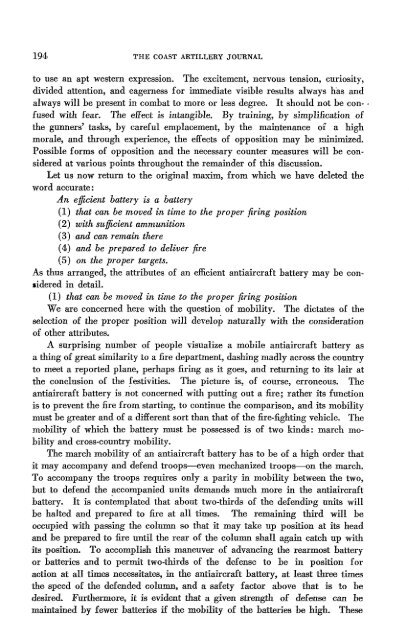THE COAST ARTILLERY JOURNAL - Air Defense Artillery
THE COAST ARTILLERY JOURNAL - Air Defense Artillery
THE COAST ARTILLERY JOURNAL - Air Defense Artillery
Create successful ePaper yourself
Turn your PDF publications into a flip-book with our unique Google optimized e-Paper software.
194 <strong>THE</strong> <strong>COAST</strong> <strong>ARTILLERY</strong> <strong>JOURNAL</strong><br />
to use an apt western expression. The excitement, nervous tension, curiosity,<br />
divided attention, and eagerness for immediate visible results always has and<br />
always will be present in combat to more or less degree. It should not be con- .<br />
fused with fear. The effect is intangible. By training, by simplification of<br />
the gunners' tasks, by careful emplacement, by the maintenance or a high<br />
morale, and through experience, the effects of opposition may be minimized.<br />
Possible forms of opposition and the necessary counter measures will be considered<br />
at various points throughout the remainder of this discussion.<br />
Let us now return to the original maxim, from which we have deleted the<br />
word accurate:<br />
An efficient battery is a battery<br />
(1) that can be moved in time to the proper firing position<br />
(2) with sufficient ammunition<br />
(3) and can remain there<br />
(4) and be prepared to deliver fire<br />
(5) on the proper targets.<br />
As thus arranged, the attributes of an efficient antiaircraft battery may be conlidered<br />
in detail.<br />
(1) that can be moved in time to the proper firing position<br />
We are concerned here with the question of mobility. The dictates of the<br />
selection of the proper position will develop naturally with the consideration<br />
of other attributes.<br />
A surprising number of people visualize a mobile antiaircraft battery as<br />
a thing of great similarity to a fire department, dashing madly across the country<br />
to meet a reported plane, perhaps firing as it goes, and returning to its lair at<br />
the conclusion of the festivities. The picture is, of course, erroneous. The<br />
antiaircraft battery is not concerned with putting out a fire; rather its function<br />
is to prevent the fire from starting, to continue the comparison, and its mobility<br />
must be greater and of a different sort than that of the fire-fighting vehicle. The<br />
mobility of which the battery must be possessed is of two kinds: march mobility<br />
and cross-country mobility.<br />
The march mobility of an antiaircraft battery has to be of a high order that<br />
it may accompany and defend troops-even mechanized troops---on the march.<br />
To accompany the troops requires only a parity in mobility between the two,<br />
but to defend the ~ccompanied units demands much more in the antiaircraft<br />
battery. It is contemplated that about two-thirds of the defendiPg units will<br />
be halted and prepared to fire at all times. The remaining third will be<br />
occupied with passing the column so that it may take up position at its head<br />
and be prepared to fire until the rear of the column shall again catch up with<br />
its position. To accomplish this maneuver of advancing the rearmost battery<br />
or batteries and to permit two-thirds of the defense to be in position for<br />
action at all times necessitates, in the antiaircraft battery, at least three times<br />
the speed of the defended colnmn, and a safety factor above that is to be<br />
desired. Furthermore, it is evident that a given strength of defense can be<br />
maintained by fewer batteries if the mobility of the batteries be high. These
















